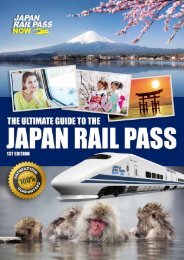Japan Rail Pass Now - Japan Travel Guide
Japan Travel Guide by Japan Rail Pass Now (www.japanrailpass.com.au)
Japan Travel Guide by Japan Rail Pass Now (www.japanrailpass.com.au)
You also want an ePaper? Increase the reach of your titles
YUMPU automatically turns print PDFs into web optimized ePapers that Google loves.
Brief History of <strong>Japan</strong><br />
The long history of <strong>Japan</strong>, which is believed to have begun as far back as the prehistoric era, can be divided into four periods — prehistoric and<br />
ancient, classical, medieval, and modern.<br />
Prehistoric and Ancient Period (35,000 BC – 538 AD)<br />
The prehistoric and ancient era of <strong>Japan</strong> covers the time up until 538 AD, including the Paleolithic (from 35,000 BC to 14,000 BC), Jomon (from<br />
14,000 BC to 300 BC), Yayoi (from 300 BC to 250 AD), and Kofun (from 250 to 538) periods.<br />
The earliest human beings to live in the <strong>Japan</strong>ese archipelago existed during the Stone Age, specifically in the Paleolithic period. They are<br />
believed to have developed skills that enabled them to make tools from stone.<br />
Eventually, they built the foundation of the Jomon culture, which is one of the world’s oldest societies, known for their hunting and gathering<br />
practices. In addition to tool-making, they also started shaping pottery with a rope pattern design using wet clay and creating jewellery from<br />
shells, stones, bones, antlers, and other materials.<br />
By the start of 300 BC, rice farming and metallurgy of iron and bronze arose. This period, which lasted until 250 AD, is referred to as Yayoi<br />
(meaning “new life”) in reference to an area in Tokyo where artefacts from this era were unearthed.<br />
The years 250 to 538 witnessed the earliest documented history of <strong>Japan</strong>. This period is known as Kofun, and it saw the introduction of<br />
Shintoism and the rise of the Imperial House of <strong>Japan</strong>.<br />
Classical Period (538 – 1185)<br />
The Classical Period opened with a big leap in the political, social, and artistic aspects of the <strong>Japan</strong>ese society, including the fruition of the<br />
Yamato rule and the beginnings of Buddhism in <strong>Japan</strong>. This formative stage is known as the Asuka period.<br />
When the Nara period started in 710, the number of <strong>Japan</strong>ese villages that practiced agriculture and followed Shintoism started to increase.<br />
Meanwhile, the nobles and elite adopted much of the Chinese culture, specifically fashion, writing and Buddhism.<br />
Closing out the Classical <strong>Japan</strong>ese era is the Heian period, which started in 794 and ended in 1185, and saw the peak of Taoism, Buddhism,<br />
poetry, literature and art in <strong>Japan</strong>ese society.<br />
221 - <strong>Japan</strong> <strong>Travel</strong> <strong>Guide</strong>



